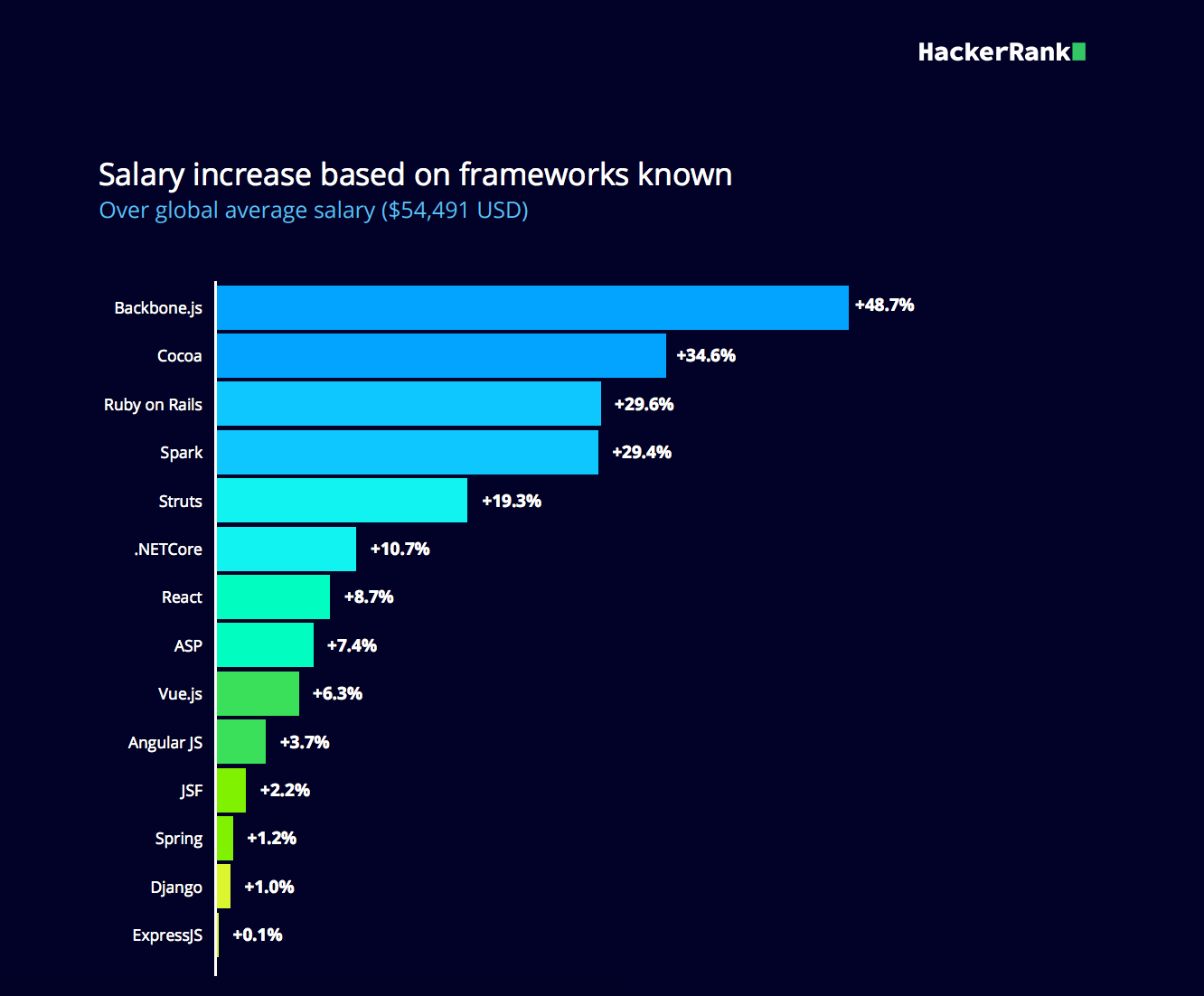When it comes to programming languages, JavaScript is by far the most well-known. In fact, more than 90% of all web pages use this technology. Accordingly, JavaScript developers currently enjoy incredibly high demand. For this reason, if your company needs to hire a JavaScript programmer, you should know it isn’t an easy task.
According to recent studies, the average salaries for top engineering roles in the US grew noticeably in 2021. Likewise, hiring an engineer isn’t easy or cheap. However, we have created a detailed guide to help you overcome this high demand and hire the best JavaScript developer for your company.
This article begins by exploring how JavaScript’s popularity affects your hiring process. Then, we analyze the average salaries of JavaScript developers worldwide and the various hiring-model options. Let’s dive deeper into what you need to know before you hire a software engineer.
Table of Contents
How JavaScript’s Popularity Affects the Hiring Process?
JavaScript is the most popular programming language because most websites use it. For example, many huge platforms we know, like Google, Wikipedia, Facebook, and YouTube, used JavaScript to build their sites.
JavaScript is still the best-known programming language in the world in 2024. Additionally, JavaScript frameworks such as Angular.js, Experss.js, and Vue.js are in the top 10 best-known frameworks worldwide. Furthermore, React.js made this list as one of the top-known JavaScript libraries.
Moreover, in 2023, JavaScript remained among the top 5 programming languages by volume of active tests. So, how does JavaScript’s popularity affect your hiring process? Well, since the language is the most popular, the demand for JavaScript developers is enormous.
For instance, a senior JavaScript developer with good technical experience, a proactive work approach, and fluent English can make between $7.5K to $10.5K monthly, depending on the hiring model.
| In-house hiring in the US | Staff augmentation via YouTeam | Freelance contractor on Upwork | |
| Average monthly payment to Senior JavaScript Developer | $14,229 | $10,200 | $9,297 |
| Extra costs for the company | Taxes, bonuses, non-financial benefits, office rent, and support | YouTeam commission | Upwork commission |
| Hiring costs | HR costs, job promotional ads | YouTeam does candidates’ sourcing and assists with interviews for free | Managers’ time for candidate sourcing, screening, and interviewing |
Source: GlassDoor, YouTeam, Upwork
By itself, knowledge of JavaScript only adds approximately 2.2% to the developer’s salary if we compare it with an average salary worldwide. However, as soon as the developer knows specific JS libraries and frameworks, the situation changes significantly. For example, Backbone.js alone can provide a 48.7% salary increase for a developer job.
The value of JS frameworks and libraries is so high because they provide almost an infinite number of possibilities to the language created for front-end development. For instance, Express.js and Node.js make it possible to develop different server-side tools using JavaScript. However, in this way, JS also becomes a language for back-end developers. Therefore, developers can complete the entire application development process in JavaScript. That is why mastering JS is most often the first step to becoming a full-stack developer.
Later in this article, we will examine how different hiring models and engagement types can help businesses to solve the problem of extreme demand for JavaScript experts in the most cost-effective way.
Still, before we analyze those alternative hiring models, we will have a look and compare the average income of JavaScript developers worldwide.
What Is the Average Salary of a JavaScript Developer Worldwide?
How can information about average salaries worldwide benefit your JavaScript engineer hiring process?
This question can be divided into two parts:
- “Why is it good to know a JavaScript developer’s average salary?” and,
- “Why should you know JavaScript developer salary rates worldwide?”
Let’s focus on the first question. An average salary is only a benchmark – it’s the amount of money that gets the attention of an average JavaScript developer. Think of it as a starting point to calculate your development costs.
So, if you decide to hire an in-house developer at the industry’s average salary, your development costs will include their salary, taxes, office costs, vacations, and other benefits.
However, if you want to hook a top JavaScript developer for your team, you need to pay over the average developer’s salary accordingly. The more profound an expert you want to hire, the more money you need to spend.
If we were to answer the second question 20 years ago, the answer would have been that knowing the average salaries worldwide can’t benefit you.
However, due to technological development and the growth in the popularity of remote work, companies are no longer limited to local talent. Therefore, companies can hire a developer from anywhere in the world easily and effectively. As mentioned above, various hiring models have altered the marketplace.
Today geography is one of the most important parameters that affect the average salary of a JS developer. More precisely, the average salary of software engineers is highly influenced by the engineer’s country of origin. So, let’s analyze those wage differences.
Developers in North and Latin America
Like most developers, JavaScript engineers in the US garner some of the highest average incomes worldwide. More precisely, a JavaScript engineer in the US has an average base pay of around $100K per year.
On the flip side, Latin American countries have a lower cost of living. As a result, the base salary for JavaScript engineers in countries like Mexico is lower. For example, JS developers located in Mexico are earning around $57K yearly in 2024. Therefore, Latin American countries provide much more affordable engineers than the US.
| Country | Junior, $ | Middle, $ | Senior, $ |
| Mexico | $39,000 | $58,000 | $87,000 |
| Brazil | $28,000 | $53,000 | $88,000 |
| Costa Rica | $30,000 | $71,000 | $98,000 |
| Uruguay | $35,000 | $64,000 | $85,000 |
| Colombia | $23,000 | $35,000 | $65,000 |
Source: Glassdoor, Indeed, PayScale
Read more about developers in Latin America.
European Developers
Now, let’s have a look at European salaries for developers. Obviously, the same situation applies to Western and Eastern European countries. To be more precise, countries with higher costs of living, like Germany and the UK, have more significant base wages than countries like Ukraine, the Czech Republic, Hungary, and Bulgaria.
As of 2024, a JavaScript developer located in Germany makes around $72K yearly. Accordingly, software engineers in the UK earn an average salary of $78K per year. On the other side, Ukrainian and Bulgarian JavaScript engineers earn around $35K and $30K, respectively.
| Country | Junior, $ | Middle, $ | Senior, $ |
| Czech Republic | $56,000 | $75,000 | $103,000 |
| The UK | $46,000 | $78,000 | $89,000 |
| Poland | $42,000 | $70,000 | $92,000 |
| Ukraine | $38,000 | $54,000 | $84,000 |
| Hungary | $34,000 | $47,000 | $63,000 |
| Bulgaria | $30,000 | $50,000 | $70,000 |
Source: Glassdoor, Indeed, PayScale
Read more about developers in Eastern Europe.
Developers from Africa and Asia
As with Eastern European countries like Ukraine or Serbia, most JavaScript devs in Africa and Asia earn relatively lower salaries. More precisely, average JavaScript developers in India don’t earn more than $9K, and software engineers in South Africa earn around $30K per year.
| Country | Junior, $ | Middle, $ | Senior, $ |
| India | $17,000 | $27,000 | $35,000 |
| China | $21,000 | $37,000 | $52,000 |
| Philippines | $14,000 | $26,000 | $34,000 |
| South Africa | $23,000 | $58,000 | $89,000 |
| Egypt | $5,000 | $14,000 | $32,000 |
| Kenya | $8,000 | $34,000 | $47,000 |
Source: Glassdoor, Indeed, PayScale
Engineers in Africa, Asia, Eastern Europe, and South America have lower salaries than their colleagues from countries with higher costs of living. Sometimes, hiring from these regions is the only way for tech companies to build their team with top-notch developers.
However, hiring from these regions can be different. For example, a company might open a remote development center in an offshore country, which is very similar to hiring in-house. They can then delegate the development process to the outsourcing team, temporarily reinforcing their team with an expert via a staff augmentation model, or hire a local freelance JavaScript developer.
To understand which option is better in every particular case, we have gathered several options for hiring a JavaScript developer. Thus, by the end of the next chapter, you will have learned about alternative hiring models your company can utilize during your upcoming development team augmentation.
What Are the Options for Hiring a JavaScript Developer?
We have already mentioned how geography can influence your decision if you need to hire a JavaScript developer. Let’s go through the main options you have here.
Hiring a JavaScript Developer Based on Geography
When it comes to geography, you have three different hiring solutions: you can hire a local engineer, a nearshore developer, or entrust your project to an offshore developer. Let’s explore the differences.
Hiring a Local JavaScript Developer
This is the traditional hiring strategy familiar to most companies. The talent pool is limited to candidates that live where the hiring company operates.
This approach has multiple pros, such as:
- the ability to meet in person at any time
- working in the same office
- speaking the same language
- having the same or very similar cultural background
- having the same country of residence
- working under the same laws
- having a familiar tax system
All of this should help make working and communicating with each other smoother.
However, the main con of this type of hiring model is that you’re limited to a small number of candidates. Even if you live in a metropolitan city, when you want to hire an expert for a position requiring a high level of proficiency, you often must battle other companies for the best-suited employees.
In terms of the organization of candidate sourcing, there are a vast number of places to find a local engineer. These types of resources include online job boards like Wellfound and Glassdoor to hiring through recruiting services. You should also consider checking local tech conferences and hackathons to find the highest-quality developers for your company. This curated list of regional and local JS meetups and conferences can be handy in this regard.
Hiring a Nearshore Or Offshore JavaScript Developer
On the flip side, you can choose to hire nearshore or offshore developers for your JavaScript projects. Remote web development became a brilliant alternative to traditional hiring, at first, because of its cost-savings, but now mostly due to the access to a unique talent.
The difference between nearshore or offshore hiring is the distance between the hiring company (client) to the development center (engineer/s). In the first case, it’s focused on the nearest neighboring countries, and in the latter—on more distant countries. For example, for US companies, developers from Mexico would be nearshore partners, but if they were from Poland, they would be offshore.
The pros and cons here are similar — with slight differences — driven primarily by geographical aspects. The pros of both nearshore and offshore software development are the ability to choose from a broader talent pool to find the exact specialist you need. In addition, most of the time, their salaries would be lower than their colleagues from North America, Western Europe, or Australia simply because of their lower costs of living. Hence, that is how nearshore and offshore hiring become cost-effective solutions for businesses.
Among the cons, the most important is working with a contractor that operates in another legal field which requires more studies at the beginning. Additionally, remote work and not having enough overlapping business hours can be a pitfall for some companies. However, in the post-COVID-19 business world, having common working hours is getting less important. Therefore, many companies prefer to work with nearshore developers with whom it’s easier to be in touch during the same working hours or organize business trips to meet in person.
Cultural differences and language barriers in cosmopolitical times might or might not be a problem. For instance, many developers from India or Egypt are fluent in English and, thus, easier to work with. In any case, this is something companies should pay attention to during the hiring process.
When you’re looking for a dev partner in a foreign country, you should always ask for third-party recommendations. Fortunately, there are numerous B2B online platforms like Clutch and G2 that can help you find trusted companies with the expertise you require.
Therefore, many huge companies and startups alike choose this solution since hiring nearshore or offshore developers is now easier, cheaper, and more effective than hiring locally.
Hiring a Javascript Developer Based on Engagement Type
Now that we have analyzed your options based on geography, let’s look at the different hiring models for the engagement type. If you want to hire a JavaScript developer, most likely you’ll want to start with one of the following four engagement types:
- In-house software development
- Freelancing
- Staff augmentation
- Outsourcing
Let’s explore each engagement type’s pros and cons. Ultimately, by the end of this chapter, you will know which solution is the best for your company’s app development needs.
1. Hiring an In-House JavaScript Developer
Hiring an in-house developer is the most traditional way of finding and adding talent to your team. Most often, companies hire in-house local candidates. Therefore, all the tips we mentioned above about hiring local developers can be applied here.
If you believe in the power of networking, we recommend you check out these top JS events: JSCAMP, JSConf, JSNation, and JSHeroes.
Even though this is an excellent solution for those looking for full-time workers, it is also the most expensive solution. More precisely, if you choose to hire an in-house JavaScript engineer, you have to compensate the employee with their salary plus any fringe benefits, such as insurance and paid vacations. For this reason, this is a safe, yet ultimately expensive engagement strategy.
In this type of working relationship, commitment between the developer and employer is the strongest.
2. Hiring a JavaScript Freelancer
If you are looking for temporary help with short-term tasks, freelancers are one of the best ways to go. By hiring a freelancer, all you have to do is wait for them to finish the task and pay afterward.
There are numerous trustworthy online platforms like Upwork, Toptal, and Freelancer to help you find a great freelancer for your development needs.
Although freelancers are usually the most affordable engagement type, they are not the safest option. For example, you could face delays and even project cancellations. This type of working relationship has the lowest level of commitment between a client and a developer. Therefore, freelancing is an excellent engagement type for short-term projects but not ideal for big JavaScript projects.
So, what should you do if you need temporary cooperation to support your core team working on a big project? Well, in that case, staff augmentation is simply the best solution.
3. Hiring JavaScript Engineers via Staff Augmentation
Staff augmentation recently became an innovative concept in software outsourcing. It means that an engineer employed with a dev shop temporarily becomes a team member of the client’s development team. In this way, a client company can involve a real expert on terms slightly softer compared to in-house hiring. Just like freelancing, staff augmentation is a temporary engagement model. Nevertheless, staff augmentation is a safer choice than freelancing and more affordable than in-house hiring.
In this type of working relationship, a developer is 100% dedicated to the project, but commitment from an employer is lower than with in-house staff and the contract can be terminated at any time.
As always, you should check third-party reviews about the companies you’re going to work with before signing a contract. One more option we can proudly suggest for staff augmentation is hiring via the YouTeam platform. In YouTeam’s talent pool, you will find only engineers from trusted dev shops that were vetted by us. This can substantially shorten your hiring time.
| Minimal Hourly Rate | Maximal Hourly Rate | Average Hourly Rate | |
| Junior JS Developer | $25 | $52 | $32 |
| Middle JS Developer | $45 | $97 | $52 |
| Senior JS Developer | $55 | $155 | $67 |
JavaScript developer hourly rates. Source: YouTeam
Browse 200+ JavaScript Developers Available for Hire
However, what should you do if you want a full-time JavaScript engineer or even the whole dev team, but you don’t have time to manage these new employees? In that case, outsourcing is the best solution.
4. Hiring JavaScript Development Teams via Outsourcing Services
Outsourcing is a very similar engagement type to staff augmentation. In both scenarios, your contractor is a development company. However, when you choose the classic outsourcing model, you hire a whole dedicated team of specialists that will work on your problem. It’s a good solution for long-term, complex projects, or when you don’t want to be involved in each and every small detail of the working process.
If your company is located in the US or another more expensive country, you can outsource your development team to more affordable regions.
Online B2B platforms include many outsourced software developers and dev teams for you to choose from. With outsourced developers, all your company has to do is host an interview with a full-stack developer suggested by an outsourcing partner and find the best candidate for your needs.
However, are developers from countries like Ukraine or India trustworthy? Do they have the same experience and skillset as engineers from the US? Let’s answer these reasonable questions with some recent facts and studies.
JavaScript Engineers’ Expertise: The US vs. Europe vs. Asia
To answer those questions, we will utilize recent research by HackerRank. According to this research, developers from countries like Ukraine are not only experienced enough but, in many cases, achieve a better IT score than developers from the US.
To be more precise, Ukrainian developers had a fantastic score of 88.7% across HackerRank’s tasks, which gave Ukraine 11th place on the scoreboard. On the other side, US developers ranked in 28th place and Indian engineers at 31st place.
Thus, according to this research, many countries like Ukraine, Romania, Moldova, Turkey, and Mexico provide top-tier developers. We have also created a table to compare developers from the US, Ukraine, and India regarding other crucial parameters, such as time convenience and English proficiency.
| The US | Ukraine | India | |
| Salary | $120K | $52K | $31K |
| Time Convenience | Perfect for the US and Europe. | Perfect for Western European countries and the US.
Big time differences with Australia. |
Big time differences between European countries and the US. Suitable for Australia. |
| English Proficiency | Native | Intermediate to High level of English | Basic to High level of English |
| Skills | Ranked 28th | Ranked 11th | Ranked 31st |
One more fact that differs among developers from typical outsourcing countries such as Ukraine and client-side countries like the US is specialization. While US developers may have a wider range of experience with various programming languages and frameworks, it’s possible that they may not have the same level of in-depth expertise in each of them.
In contrast, developers from Ukraine usually have one or two core technologies in which they are experts. You can find developers with 5–8 years of experience in JavaScript, but they might not be so familiar with some particular libraries. Such expertise in one field is basically everything companies might wish for when they need to temporarily involve a professional for the solution of some particular problem. In this case, such an expert can deal with a problem faster.
However, learning one library for a professional developer with 5+ years of experience in a similar niche is a piece of cake. So, the absence of, let’s say, Meteor or Express.js in a CV of a JavaScript developer is not always a red flag. What’s more important are the problem-solving abilities and the personal qualities of the candidate.
Interviewing a JavaScript Developer: What Questions Should You Ask?
Suppose you choose to hire a JavaScript developer through a staff augmentation model, and you want to host interviews with different candidates for the job. What are the best questions to ask if you want to ensure that you hire the best developer for the job? We separated the questions into two main categories: hard skills and soft skills.
- Hard skills. You should make sure that the interviewee has the technical skills you seek. Therefore, you can ask questions about their previous experience and JavaScript knowledge (i.e., the language’s features, how to create cross-platform web applications through JavaScript, relevant JS frameworks like Node.js, React.js, or Angular.js, markups like HTML or CSS, functionality questions, etc.). For inspiration, check this list of 100 JS interview questions with answers. All these questions will help you quickly verify a candidate’s hard skills.
- Soft skills. After examining an interviewee’s skills, you can ask questions to make sure they are the cultural fit with the background you need. In fact, it is vital to ensure that the web app’s developer is a good team player with the soft skills you need and will fit perfectly into your company. We recommend our remote developer interview tool that helps you prepare for the soft skills interview in five minutes — 150 questions divided into 15 categories to assess the interviewee’s personal qualities.
For all temporary types of cooperation, we recommend conducting hard skills evaluation first. The reason behind this is that expertise is what is the most important in a short-term perspective.
However, when you hire a team member in-house, we suggest reversing the order. First, you need to be sure that the person is a good fit for your team. Only after a successful interpersonal interview, does it make sense to go further with a technical evaluation.
How to Assess JavaScript Developer Skills Using Code Testing Platforms
Online platforms for JavaScript developer skills assessment help businesses determine which engineer best meets the technical skills requirements before moving candidates to later interviewing rounds. We selected five services that can help companies identify skills beyond talent profiles and resumes.
1) HackerRank
With HackerRank, technical managers create role-specific online coding assessments and invite JavaScript developers to take the challenge. Then, the skills screening platform automatically reviews, scores, and ranks candidates to pinpoint the best-fit engineers.
2) Hatchways
Hatchways offers customized interviews for each company based on factors that research has shown to provide the most fair and inclusive interview experience.
3) Adaface
This platform offers a range of assessments to evaluate programmers on JavaScript fundamentals, asynchronous programming, and the ability to structure and style HTML DOM. The platform creators claim that they have non-googleable questions — their crawlers check if any questions have leaked online, and if they have, the test makers change those questions.
4) TestGorilla
The platform’s JavaScript tests are designed by subject matter experts. They evaluate a candidate’s ability to program algorithms, manipulate data structures, effectively use jQuery, and debug JavaScript code.
5) Woven
Woven technical assessments stand out as a human-powered evaluation process, distinguishing themselves from automated assessments. Each assessment, ranging from 90 to 120 minutes for candidates, is reviewed and scored by experienced engineers, offering a personalized and nuanced evaluation.
Where to Find JavaScript Developers
You can try to find developers directly in places where they are active. We’ve already mentioned a few JS conferences that can be a nice spot to find active engineers. Another direction to think about is online communities and specialized websites for JavaScript developers. We’ve collected a list of such resources for you:
- JavaScript Developers at YouTeam
- JavaScript on Reddit
- Learn JavaScript on Reddit
- JavaScript Community on Dev.to
- JavaScript tread on StackOverflow
Why Is YouTeam the Best Solution to Help You Hire JavaScript Developers for Your Business?
When it comes to hiring a professional JavaScript developer via staff augmentation or through a flexible outsourced model, YouTeam is the best solution. Let’s see why:
- Fast matching with clients’ needs: With YouTeam, you can quickly find the best developers. Our platform has selected the most reliable and top-performing development agencies from Latin America and Eastern Europe. Access to engineers of these agencies makes it possible to find exactly what our clients need in less than 48 hours.
- Top-tier developers: Unlike freelancers or individual developers, the engineers in our talent pool have gone through a multi-step selection process. In addition, most of them are senior professionals. As a result, our candidate to hire ratio is 1.75.
- Flexibility: YouTeam authorizes you to interview as many developers as you need. And if you decide to scale your team at any point in your project, we will help you to make this easy and effective.
- There are no hidden costs for our clients: If you choose to hire a JavaScript developer with YouTeam, the sourcing and interviewing process is risk-free. You pay only for the developer’s work, and you know the final rates from the very beginning as they are displayed on each candidate’s profile.
- Numerous good reviews from previous clients: On our platform, you can check all the reasons why YouTeam is your best choice. Our clients trust our vetting process and choose to stay with YouTeam after trying our white-glove service.
Conclusion
As JavaScript is the most popular programming language, hiring a top-tier developer has become challenging and expensive. For this reason, we explored alternative hiring models to reduce costs, without compromising quality.
After analyzing the average salaries globally, we found that outsourcing destinations such as Ukraine, Georgia, Bulgaria, and Mexico offer top-notch developers at an affordable price.









